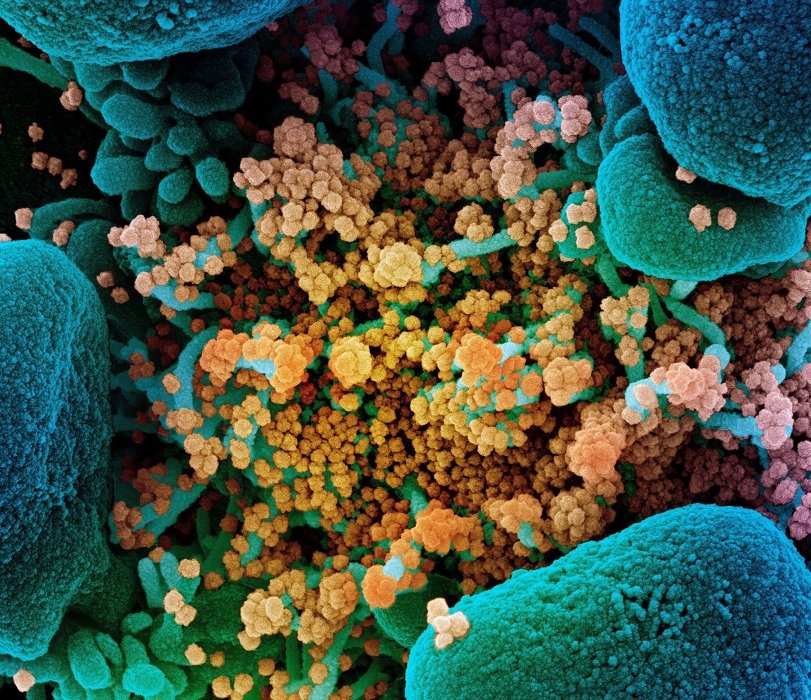
Credit: NIAID Integrated Research Facility, Fort Detrick, Maryland.
News • The coronavirus evolves
COVID-19 variants may offer clues in predicting patient outcomes
Researchers from Cleveland Clinic and Case Western Reserve University collaborate on genetic study of SARS-CoV-2 mutations. Results show how the different COVID-19 clades evolved.
Since the start of the COVID-19 pandemic, mutations of SARS-CoV-2—the virus that causes COVID-19—have spread to the U.S. and a host of other countries worldwide. Recent studies suggest that current COVID-19 variants are up to 70% more contagious than the pandemic's original strains.
A multidisciplinary team of scientists at Cleveland Clinic and Case Western Reserve University used genomic sequencing to track SARS-CoV-2 as it mutated in Northeast Ohio from March 11 to April 22, 2020. The research findings, published in JAMA Network Open, demonstrated that initial strains and subgroups of virus strains (called clades), seen during this time period, were associated with higher mortality while newer variants were associated with lower hospitalizations and deaths. Although these findings share insight to what researchers learned earlier in the pandemic, it could also help guide future studies to analyze how the newer variants impact patient outcomes as the virus continues to evolve.
To better understand how the earlier mutations and clades altered clinical outcomes, Dr. Esper and the team of researchers analyzed the RNA sequences of data from 302 patients with COVID-19 during the first wave of the pandemic in Northeast Ohio. These clinical samples were obtained from Cleveland Clinic's COVID-19 registry, a collection of data from nearly 50,000 patients who had been tested for the disease.
By sequencing each specimen against the initial strain of the virus discovered in Wuhan, China, Dr. Esper and the research team identified 488 unique mutations, correlating with six virus strains (clades Wuhan, S, L, V, G, GH).
Results revealed that during the initial six weeks of the pandemic in Cleveland, the early virus strains were well established and contributed to higher incidents of death from the disease. However, within weeks these early virus strains were outpaced by more transmissible strains that were associated with lower hospitalizations and increased patient survival even when hospitalized.
"This study offers a detailed description of how the different COVID-19 clades evolved and competed once they were brought to Cleveland," said Brian Rubin, M.D., chair of Robert J. Tomsich Pathology and Laboratory Medicine Institute, Cleveland Clinic. "The linkage of viral clades to outcomes is quite important and highlights the importance of viral genome sequencing to gain a deeper understanding of new diseases."
The greatest diversity of COVID-19 strains occurred in the first weeks before community strategies to limit viral spread were established. It is likely that state and federal responses may have prevented continued introduction of new variants from outside the community, and thereby decrease overall mortality.
"These findings offer greater insight into how COVID-19 infections significantly outpaced the rates of COVID-19 hospitalizations and deaths as the pandemic progressed," said Frank Esper, M.D., a pediatric infectious disease physician at Cleveland Clinic Children's. "The research also helps to validate how viral clades can play an important role in predicting patient outcomes."
"This study further confirms the importance of studying genomic variants of the virus throughout the pandemic," added Jing Li, Ph.D., the Leonard Case Jr. Professor of the Department of Computer and Data Sciences, Case Western Reserve University. "It also clearly demonstrates the value of team science—a highly integrated and interactive team with different strengths and expertise but a shared vision—in addressing the challenge."
As the virus continues to mutate over time, experts are not certain of the disease severity or mortality the new variants will cause. Widespread vaccination is an important public health strategy to slow the spread of the virus. Widespread vaccinations will help reduce the appearance of potentially deadly variants. Until herd immunity is achieved—which experts estimate is about 70-80% of the population being vaccinated—everyone should continue to mask, social distance, wash hands frequently and avoid gatherings. Currently, just 34% of Americans are fully vaccinated, while 52% have received at least one dose, according to the U.S. Centers for Disease Control and Prevention.
Source: Cleveland Clinic
27.04.2021







